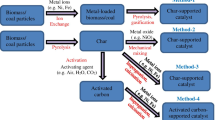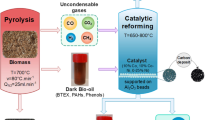Abstract
Environmental concerns and oil price rises and dependency promoted strong research in alternative fuel sources and vectors. Fischer-Tropsch products are considered a valid alternative to oil derivatives having the advantage of being able to share current infrastructures. As a renewable source of energy, synthesis gas obtained from biomass gasification presents itself as a sustainable alternative. However, prior to hydrocarbon conversion, the bio-syngas must be conditioned, which includes the removal of carbon dioxide for subsequent sequestration and capture. A pressure swing adsorption cycle was developed for the removal and concentration of CO2 from the bio-syngas stream. Activated carbon was chosen as adsorbent. The simulation results showed that it was possible to produce a (H2 + CO) product with a H2/CO stoichiometric ratio of 2.14 (suitable as feed stream for the Fischer-Tropsch reactor) and a CO2 product with a purity of 95.18%. A CO2 recovery of 90.3% was obtained. A power consumption of 3.36 MW was achieved, which represents a reduction of about 28% when compared to a Rectisol process with the same recovery.
Similar content being viewed by others
Abbreviations
- a p :
-
particle specific area (m−1)
- A :
-
virial coefficients (m2 mol−1)
- B :
-
virial coefficients (m4 mol−2)
- Bi i :
-
mass Biot number of component i, \((\mathit{Bi}_{i}=\frac{a_{p}k_{f}R_{p}^{2}}{\varepsilon _{p}8D_{p,i}})\) (–)
- C g,i :
-
gas phase concentration of component i (mol m−3)
- C g,T :
-
total gas phase concentration (mol m−3)
- C p :
-
gas mixture molar specific heat at constant pressure (J mol−1 K−1)
- \(\overline{C_{p,i}}\) :
-
average concentration of component i in the macropores (mol m−3)
- \(\hat{C}_{ps}\) :
-
particle specific heat at constant pressure (per mass unit) (J kg−1 K−1)
- \(\overline{C_{p,T}}\) :
-
average total concentration in the macropores (mol m−3)
- \(\hat{C}_{pw}\) :
-
wall specific heat at constant pressure (per mass unit) (J kg−1 K−1)
- C v :
-
gas mixture molar specific heat at constant volume (J mol−1 K−1)
- C v,ads,i :
-
molar specific heat of component i in the adsorbed phase at constant volume (J mol−1 K−1)
- C v,i :
-
molar specific heat of component i at constant volume (J mol−1 K−1)
- d p :
-
adsorbent particle diameter (m)
- d wi :
-
internal bed diameter (m)
- D ax :
-
axial dispersion coefficient (m2 s−1)
- D c,i :
-
micropore diffusivity of component i (m2 s−1)
- D p,i :
-
macropore diffusivity of component i (m2 s−1)
- h f :
-
film heat transfer coefficient between the gas and particle (J s−1 m−2 K−1 )
- h w :
-
film heat transfer coefficient between the gas and wall (J s−1 m−2 K−1 )
- k f :
-
film mass transfer coefficient (m s−1)
- K ∞ :
-
adsorption constant at infinite temperature (mol kg−1 bar−1)
- K H :
-
Henry constant (mol kg−1 bar−1)
- P :
-
pressure (Pa)
- \(\overline{q_{i}}\) :
-
average adsorbed phase concentration of component i (mol kg−1)
- \(q_{i}^{*}\) :
-
adsorbed concentration of component i in equilibrium with \(\overline{C_{p,i}}\) (mol kg−1)
- r c :
-
“microparticle” radius (m)
- R g :
-
ideal gas constant (J mol−1 K−1)
- R p :
-
adsorbent particle radius (m)
- t :
-
time (s)
- T g :
-
bulk phase temperature (K)
- T p :
-
solid temperature (K)
- T w :
-
wall temperature (K)
- u 0 :
-
superficial velocity (m s−1)
- y i :
-
gas phase molar fraction of component i (–)
- z :
-
axial position (m)
- α w :
-
ratio of the internal surface area to the volume of the column wall (m−1)
- (ΔH ads) i :
-
heat of adsorption of component i (J mol−1)
- ε :
-
bed porosity (–)
- ε p :
-
particle porosity (–)
- λ :
-
heat axial dispersion coefficient (J s−1 m−1 K−1)
- μ :
-
bulk gas mixture viscosity (kg m−1 s−1)
- ρ :
-
bulk gas mixture density (kg m−3)
- ρ b :
-
bed density (kg m−3)
- ρ p :
-
particle density (kg m−3)
- ρ w :
-
wall density (kg m−3)
References
Aasberg-Petersen, K., Christensen, T.S., Dybkjar, I., Sehested, J., Østberg, M., Coertzen, R.M., Keyser, M.J., Steynberg, A.P.: Synthesis gas production for FT synthesis. In: Steynberg, A., Dry, M. (eds.): Fischer-Tropsch Technology. Studies in Surface Science and Catalysis, vol. 152, pp. 258–405. Elsevier, Amsterdam/Boston (2004)
Batdorf, J.A.: Method and apparatus for methanol and other fuel production. U.S. Patent 7,655,703 (2010)
Bird, R.B., Stewart, W.E., Lightfoot, E.N.: Transport Phenomena, 2nd edn. Wiley, Singapore (2002)
Boerrigter, H., Uil, H.d., Calis, H.-P.: Green diesel from biomass via Fischer-Tropsch synthesis: new insights in gas cleaning and process design. Paper presented at the “Pyrolysis and Gasification of Biomass and Waste”, Expert Meeting, Strasbourg, France, 30 September–1 October
Boerrigter, H.: Economy of biomass-to-liquids (BTL) plants: an engineering assessment. ECN Biomass, Coal & Environmental Research (2006). http://www.thermalnet.co.uk/docs/2G-1%20ECN-C-06-0191.pdf Accessed 30 July 2010
Chlendi, M., Tondeur, D.: Dynamic behavior of layered columns in pressure swing adsorption. Gas Sep. Purif. 9(4), 231–242 (1995)
Da Silva, F.A.: Cyclic adsorption processes: application to propane/propylene separation. University of Porto (1999)
Da Silva, F.A., Silva, J.A., Rodrigues, A.E.: A general package for the simulation of cyclic adsorption processes. Adsorption 5(3), 229–244 (1999)
Da Silva, F.A., Rodrigues, A.E.: Vacuum swing adsorption for propylene/propane separation with 4A zeolite. Ind. Eng. Chem. Res. 40(24), 5758–5774 (2001)
Demirbas, A.: Biorefineries: current activities and future developments. Energy Convers. Manag. 50(11), 2782–2801 (2009)
Drage, T.C., Blackman, J.M., Pevida, C., Snape, C.E.: Evaluation of activated carbon adsorbents for CO2 capture in gasification. Energy Fuels 23, 2790–2796 (2009)
Dry, M.: Chemical concepts used for engineering purposes. In: Steynberg, A., Dry, M. (eds.): Fischer-Tropsch Technology. Studies in Surface Science and Catalysis, vol. 152, pp. 196–257. Elsevier, Amsterdam/Boston (2004)
EPA: Alternative fuels: Fischer-Tropsch. Fact sheet number EPA420-F-00-036. http://www.afdc.energy.gov/afdc/pdfs/epa_fischer.pdf (2002). Accessed 30 July 2010
Fischer, F., Tropsch, H.: Die Erodölsynthese bei gewöhnlichem Druck aus den Vergangsprodukten der Kohlen. Brennst.-Chem. 7, 97–104 (1926)
Fuderer, A., Rudelstorfer, E.: Selective adsorption process. U.S. Patent 3,986,849 (1976)
Grande, C.A., Lopes, F.V.S., Ribeiro, A.M., Loureiro, J.M., Rodrigues, A.E.: Adsorption of off-gases from steam methane reforming (H2, CO2, CH4, CO and N2) on activated carbon. Sep. Sci. Technol. 43, 1338–1364 (2008)
Herzog, H.: The Economics of CO2 Separation and Capture. http://sequestration.mit.edu/pdf/economics_in_technology.pdf (2000). Accessed 30 July 2010
Higman, C., van der Burgt, M.: Gasification, 2nd edn. Elsevier, Amsterdam (2008)
Kuester, J.L., Scottsdale, A.: Process of producing liquid hydrocarbon fuels from biomass. U.S. Patent 4,678,860 (1987)
Kumar, R., Kratz, W.C.: Separation of Multicomponent Gas Mixtures by Selective Adsorption. U.S. Patent 5,133,785 (1992)
Kunze, C., Spliethoff, H.: Modelling of an IGCC plant with carbon capture for 2020. Fuel Process. Technol. 91(8), 934–941 (2010)
Lu, Y.J., Lee, T.: Influence of the feed gas composition on the Fischer-Tropsch synthesis in commercial operations. J. Nat. Gas Chem. 16(4), 329–341 (2007)
Lv, P.M., Chang, J., **ong, Z.H., Huang, H.T., Wu, C.Z., Chen, Y., Zhu, J.X.: Biomass air-steam gasification in a fluidized bed to produce hydrogen-rich gas. Energy Fuels 17(3), 677–682 (2003)
McAllister, E.W.: Pipeline Rules of Thumb Handbook—Quick and Accurate Solutions to Your Everyday Pipeline Engineering Problems, 7th edn. Elsevier, Amsterdam (2009)
McCabe, W.L., Smith, J.C., Harriot, P.: Unit Operation of Chemical Engineering, 5th edn. McGraw-Hill, New Work (1993)
Ribeiro, A.M., Grande, C.A., Lopes, F.V.S., Loureiro, J.M., Rodrigues, A.E.: A parametric study of layered bed PSA for hydrogen purification. Chem. Eng. Sci. 63, 5258–5273 (2008)
Sircar, S.: Excess properties and thermodynamics of multicomponent gas adsorption. J. Chem. Soc., Faraday Trans. 81, 1527–1540 (1985)
Takeshita, T., Yamaji, K.: Important roles of Fischer-Tropsch synfuels in the global energy future. Energ Policy 36(8), 2773–2784 (2008)
Taqvi, S.M., LeVan, M.D.: Virial description of two-component adsorption on homogeneous and heterogeneous surfaces. Ind. Eng. Chem. Res. 36, 2197–2206 (1997)
Unruh, D., Pabst, K., Schaub, G.: Fischer-Tropsch synfuels from biomass: maximizing carbon efficiency and hydrocarbon yield. Energy Fuels 24, 2634–2641 (2010)
Wakao, N., Funazkri, T.: Effect of fluid dispersion coefficients on particle-to-fluid mass transfer coefficients in packed beds. Chem. Eng. Sci. 33(10), 1375–1384 (1978)
Wasch, A.P.D., Froment, G.F.: Heat transfer in packed beds. Chem. Eng. Sci. 27, 567–576 (1972)
Yang, R.T.: Gas separation by adsorption processes. Butterworths, Boston (1987)
Yin, X.L., Leung, D.Y.C., Chang, J., Wang, J.F., Fu, Y., Wu, C.Z.: Characteristics of the synthesis of methanol using biomass-derived syngas. Energy Fuels 19(1), 305–310 (2005)
Zhang, J., Webley, P.A.: Cycle development and design for CO2 capture from flue gas by vacuum swing adsorption. Environ. Sci. Technol. 42(2), 563–569 (2008)
Author information
Authors and Affiliations
Corresponding author
Rights and permissions
About this article
Cite this article
Ribeiro, A.M., Santos, J.C. & Rodrigues, A.E. Pressure swing adsorption for CO2 capture in Fischer-Tropsch fuels production from biomass. Adsorption 17, 443–452 (2011). https://doi.org/10.1007/s10450-010-9280-8
Received:
Accepted:
Published:
Issue Date:
DOI: https://doi.org/10.1007/s10450-010-9280-8




